How To Clean After Using A Fire Extinguisher
The chemicals used tin make a large departure in approaches to burn extinguisher clean-up
The red canisters hanging throughout apartment complexes, schools, or workplaces may all expect the aforementioned—but what'due south within them can vary a great bargain. A burn extinguisher's contents have a large impact not only on what fires it can fight but on how hard it'll be to make clean up the residual when all is said and done. This commodity looks at the guidelines for burn down extinguisher clean-upwardly, including:
- The costs of damage and professional repair
- How to determine what's inside the extinguisher
- Make clean-upwards for dry chemical, wet chemical, foam, and other common extinguisher types
As we explicate afterwards, replacing or refilling those extinguishers presently is a good idea and, often, a legal requirement. Feel complimentary to browse our selection of dry chemical, CO2, and specialty fire extinguishers. To learn more near how to make clean up fire extinguisher powder and balance, read on.
Abuse of fire extinguishers can vastly increase otherwise pocket-size make clean-up costs
Restoring a fire-damaged building isn't cheap. While a 1,500 foursquare pes home might need as little as $2,000 for reconstruction and deodorizing afterwards a modest fire, fixing more all-encompassing damage tin cost tens of thousands of dollars. And while the costs of extinguisher clean-up are hard to quantify—with at to the lowest degree 1 estimate placing the expense of chemic clean-up at $1,000-$two,500—the price of using an extinguisher is withal far less than the price of going without one.
However, not all uses of extinguishers are benign. Information technology'due south a lesson that the Banner School, a private primary and centre school in Frederick, Maryland, learned the difficult way. The schoolhouse closed afterward vandals discharged as many as 7 fire extinguishers in the building. A school ambassador placed the costs of clean-upward—including new furniture, carpet, computers, and servers—at no less than $140,000.
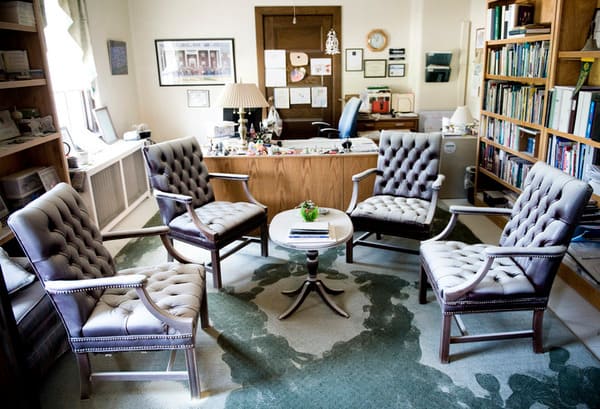
Photo past Graham Cullen
The Banner School'southward feel with burn down extinguisher make clean-up may be among the worst—but it'due south far from the but act of extinguisher vandalism. Here'southward a quick look at some incidents:
- A special needs army camp in Birch Bay, Washington reported damages exceeding $12,000 later on four dormitories were coated in chemical powder. It's the 2d such incident in two years.
- A Methodist Church in Ahwatukee, Arizona faced at least a week's worth of clean-up subsequently attackers discharged 2 dry chemic extinguishers. Worse, the spray circulated through the building's ventilation organization.
- Two "jockey-boxing" teenagers took what they could from open cars and garages in Kuna, Idaho. On the way, they sprayed vehicles with a stolen burn extinguisher and drove a car off a cliff.
Don't get-go burn extinguisher clean-up earlier figuring out what chemicals you're working with
As a first step, identify what was inside the extinguisher. This information should be listed on the extinguisher'due south characterization. Here's a listing of common fire extinguishing agents to look for:
- Dry out Chemical (Multi-Purpose Dry Chemical, ABC Dry Chemical, Regular Dry out Chemic)
- Dry Pulverisation (Graphite Dry out Pulverisation, Class D Powder, Copper Powder)
- Foam (ATC Foam)
- Moisture Chemic (Wet Agent, Moisture Chemical Agent, Liquid Amanuensis, Grade K Liquid Amanuensis)
Earlier cleaning any burn down extinguisher pulverization or residue, it's important to determine how to exercise information technology safely. Each manufacturer makes this data available through a document chosen an SDS (Condom Data Sheet). Formerly called an MSDS (Material Condom Data Sheet), these documents describe the hazards extinguisher chemicals pose and the procedures to follow when cleaning them.
If a hard copy of the SDS isn't available, visit the manufacturer's website (or use your preferred search engine) to locate a digital copy. Searching for the model number, which is often constitute on the extinguisher's label, tin make finding an exact match easy. OSHA-compliant SDSs offer clean-up guidelines in Department 6, Adventitious Release Measures. A listing of protective equipment can be found in Department 8, Exposure Controls/Personal Protection.
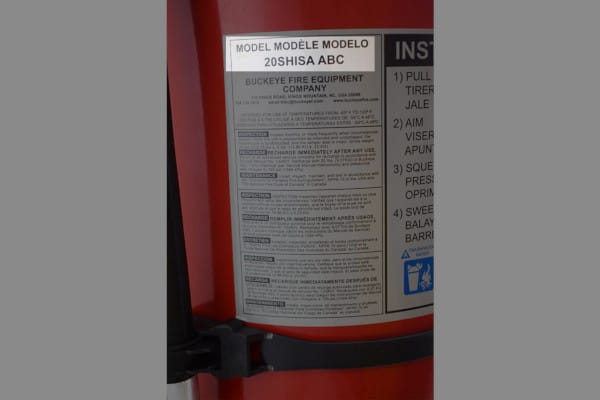
Reach out to cleaning and burn down service professionals sooner rather than afterward
The next few sections provide guidelines for cleaning upwardly after specific burn down extinguisher types. Just first, a word of circumspection: not all extinguisher make clean-upwards is a practice-it-yourself job.
Most of these agents pose picayune threat to walls and floors. Merely when an amanuensis is poised to enter waterways, plumbing systems, or a edifice's ventilation system, it'southward probably best left to professionals. Plus, permanent damage can occur if the article of furniture, carpets, electric equipment, and other materials aren't quickly cleaned.
In that location'south also the thing of getting extinguishers back into service in a timely manner. Local fire codes vary, but, in general, building owners and their representatives must fix bug with extinguishers at a brisk pace. NFPA 10 , the leading model burn extinguisher standard, requires problems to be fixed as before long equally an inspection uncovers i. Dumb or missing equipment can put occupants at risk. These situations can besides become a serious liability for those charged with a edifice's budget. Supercede extinguishers as before long as possible!
Dos and don'ts for clean-upwardly of "dry" (dry chemical or dry powder) extinguishers
Two master types of extinguishers spray a powdery, dry amanuensis:
- Dry out chemic extinguishers, a category that contains the multipurpose, ABC-rated extinguishers establish in most buildings
- Dry pulverization extinguishers are used to finish fires in flammable metal
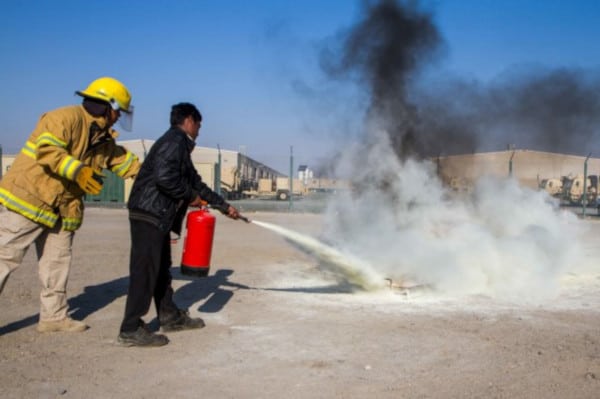
Exercise:
- Shut down the ventilation system before cleaning.
- Read the MSDS or SDS. Prevent pare and eye irritation with recommended personal protective equipment (PPE).
- Wearable a grit mask or respirator if needed. Rated dusk masks tin filter particles equally pocket-size every bit 0.3 microns—much smaller than the 20-micron particles establish in extinguishers. Await for a mask stamped "NIOSH," "N95," or "N100," which is certified to filter 95-100% of these small particles.
- Sweep and shovel the bulk of the contaminant, either using an appropriate dust suppressant or by wet-sweeping.
- Remove balance using a vacuum with a HEPA (Loftier-Efficiency Particulate Air) filter, which collects at to the lowest degree 99.97% of particles 0.3 microns and larger.
- Clean metal surfaces first. Some powders can corrode metal quickly.
- Collect residual in a bag. Dispose of information technology in accordance with land and local laws.
- Ventilate the area later on cleaning.
DON'T:
- Wash the rest into whatever drain that leads to a waterway.
- Identify collected powder back in an extinguisher.
Dry chemical burn down extinguisher clean-up advice
Typical composition: Monoammonium Phosphate, Sodium Bicarbonate, Potassium Bicarbonate
Hot tips:
- Interruption down the silicone in the dry chemical agent with a i:1 mix of isopropyl alcohol and water. Let the solution sit for a few minutes and rinse with warm water.
- Neutralize bicarbonate powders with a 49:1 solution of hot water and vinegar (1 cup of vinegar to iii gallons of water), then rinse with warm water.
- Neutralize monoammonium phosphate with a 49:1 solution of baking soda and h2o (1 loving cup baking soda to three gallons of water). Let it sit for a few minutes and remove with warm h2o.
- Wash with a balmy soap and h2o solution.
- Make clean electrical contacts with an canonical electric contact cleaner.
Additional cleaning advice: A 2013 study from the Colonial Williamsburg Foundation took a expect at the difficulty of cleaning ABC dry chemical residue from materials establish in museums and historic buildings. Their report found that many materials make clean almost entirely (what they termed "infrequent" effectiveness), while others achieve a visible make clean with minimal residue remaining ("good" effectiveness).
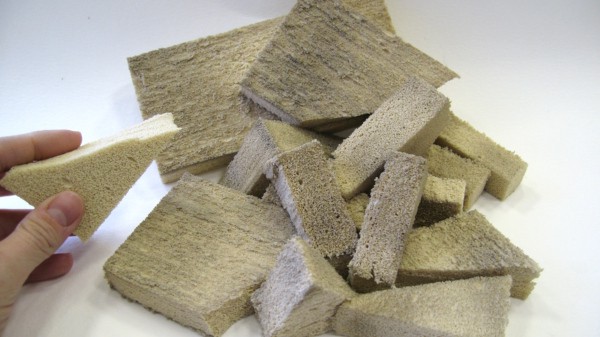
Here's what the study institute almost how to clean up dry pulverization fire extinguisher residue from various surfaces:
- Aluminum (Exceptional): Vacuum and water swab
- Brick (Exceptional): Vacuum and h2o swab
- Copper (Good): Methods including vacuums, soot erasers, and water swabs
- Iron (Proficient): Methods including vacuums, water swabs, and detergent
- Leather (Skilful): Water swabs, vacuums
- Marble (Exceptional): Soot eraser, vacuum, water swab
- Painted Canvas (Exceptional): Vacuum and water swab
- Travertine (Good): Soot eraser
- Tile (Good): Vacuum and water swab
- Forest, Unvarnished (Adept): Soot eraser
- Forest, Varnished (Good): Vacuum, soot eraser, and water swab
Dry out powder fire extinguisher clean-upwardly advice
Typical composition: Sodium Chloride, Graphite, Copper
Hot tips: These extinguishers fight Class D fires—that is, fires in flammable metallic. Some dry out pulverisation agents become combustible if airborne. Some clean hands with very little protective equipment, while others require the evacuation of nonessential staff. For safety'south sake, rely heavily on the SDS or MSDS.
Dos and don'ts for cleaning remainder from "wet" (wet chemic or foam) extinguishers
The following tips apply to two types of extinguishers:
- Wet chemical extinguishers, used primarily to control "kitchen" fires (those involving cooking grease, fat, or oils)
- Cream extinguishers, which perform well on flammable liquids besides as wood, paper, or other ordinary combustibles
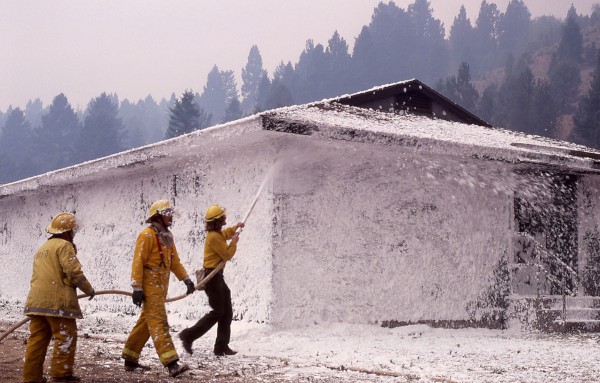
Practise:
- Read the MSDS or SDS. Prevent peel and centre irritation with recommended personal protective equipment (PPE), including splash-resistant safety goggles and impermeable gloves. Clothe arms and legs.
- Blot, pocketbook, and drum the agent for proper disposal.
DON'T:
- Launder the remainder into any drain that leads to a waterway.
- Place nerveless foam or wet agent dorsum in an extinguisher.
Foam fire extinguisher clean-up communication
Typical composition: Varies. Some comprise environmentally chancy perfluorochemicals (PFCs).
Hot tips: Big foam extinguisher spills may need to be cleaned by a professional. Even limited exposure to some foam agents can crusade harm to the nervous system or vital organs.
General guidelines:
- Don't spray the foam with water, which will generate more foam. Vacuum, pump, or use absorptive materials on the residue instead. So, remove the residue with detergent and water.
- For cream agents with known adverse wellness furnishings: Wear an air-purifying respirator for prolonged cleaning. Utilise positive-pressure air respirators—those designed to prevent the entry of contaminants using added air pressure inside the hood or helmet—around high concentrations of airborne agents. Ventilate the expanse well. Professional person make clean-up is recommended!
Wet chemic burn down extinguisher make clean-up advice
Typical composition: Potassium Acetate, Potassium Carbonate, Potassium Citrate
Hot tips: Residue from these kitchen fire extinguishers typically cleans upward with hot water and soap. Close off power to cooking equipment before cleaning. Discard any food that has come into contact with the amanuensis.
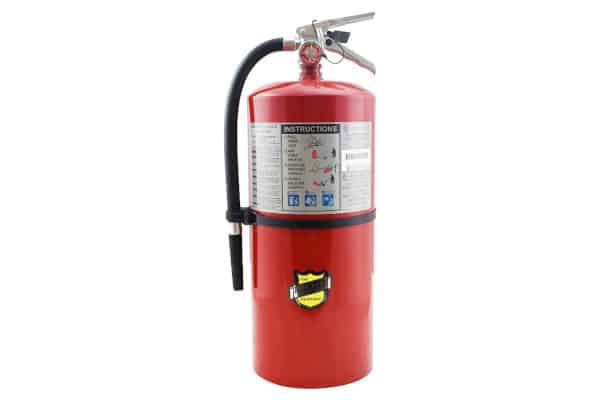
Replace exhausted extinguishers quickly from the selection at QRFS
Restoring a building after a burn or an deed of vandalism tin be an overwhelming chore. But with an understanding of an extinguisher's contents—and some how-to tips—most fire extinguisher powder or liquid residuum can be apace and safely cleaned.
If you lot need new fire extinguishers to bring your building back into compliance with burn lawmaking, take a look at QRFS's stock of extinguishers from Buckeye, a Northward Carolina-based manufacturer with a selection of UL-listed extinguishers for a broad range of hazards.
If you're not sure what extinguisher you need, take a look at the post-obit resource:
- "When and Where Should Fire Extinguishers Be Installed? A Practical Guide for Building Owners"
- "Ultimate Guide to Fire Extinguisher Classes: Servicing and Utilize"
- "What Does the Number on a Fire Extinguisher Hateful?"
Browse our option of fire extinguishers.
Even so need help? Call united states at +ane (888) 361-6662 or electronic mail [email protected].
This blog was originally posted at web log.qrfs.com. If this commodity told yous what yous needed to know well-nigh fire extinguisher clean-up, check united states out at Facebook.com/QuickResponseFireSupply or on Twitter @QuickResponseFS.
Source: https://blog.qrfs.com/211-guide-to-fire-extinguisher-clean-up/
Posted by: groveloung1959.blogspot.com


0 Response to "How To Clean After Using A Fire Extinguisher"
Post a Comment